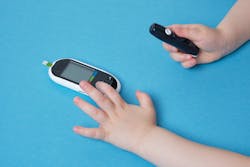The U.S. Food and Drug Administration approved Jardiance (empagliflozin) and Synjardy (empagliflozin and metformin hydrochloride) as additions to diet and exercise to improve blood sugar control in children 10 years and older with type 2 diabetes. These approvals provide a new class of medicines taken by mouth to treat pediatric type 2 diabetes. Metformin, the only other oral therapy available for the treatment of children with type 2 diabetes, was first approved for pediatric use in 2000.
Empagliflozin, the active ingredient in Jardiance and Synjardy, works by increasing the excretion of glucose in the urine. Synjardy also contains metformin.
The safety and efficacy of empagliflozin in children were studied in a double-blind, randomized, placebo-controlled trial in 157 patients aged 10 to 17 years with inadequately controlled type 2 diabetes. Participants were randomly assigned to one of three treatment arms for 26 weeks: empagliflozin, a DPP-4 inhibitor (linagliptin), or placebo. At the beginning of the trial, 51% of patients were taking metformin alone, 40% of patients were taking a combination of metformin and insulin, 3% of patients were taking insulin alone, and 6% of patients were not taking other medicines for diabetes. The trial found that, at week 26, treatment with empagliflozin was superior in reducing hemoglobin A1c, a measure of average blood sugar, compared to placebo. The 52 patients treated with empagliflozin had an average 0.2% decrease in hemoglobin A1c compared with an average 0.7% increase in hemoglobin A1c in the 53 patients taking placebo, representing a 0.8% decrease in hemoglobin A1c with empagliflozin as compared to placebo. Patients treated with empagliflozin also had reductions in fasting plasma glucose, a blood sugar measurement taken after not eating or drinking for at least eight hours, as compared to patients taking placebo.
Common side effects in children treated with empagliflozin were generally similar to those reported in adults, except there was a higher risk of hypoglycemia (low blood sugar) among pediatric patients 10 years and older taking empagliflozin compared to placebo, regardless of whether they were taking other therapies for diabetes.
The most common side effects in adults treated with empagliflozin include urinary tract infections and female fungal infections. The most common side effects in patients treated with metformin include diarrhea, nausea and upset stomach. Jardiance and Synjardy are not recommended in patients with type 1 diabetes because of an increased risk of diabetic ketoacidosis. Jardiance and Synjardy are also not recommended for use to improve blood sugar control in patients with severe kidney problems and should not be used in patients who previously have had a serious allergic reaction to them. Synjardy must not be used in patients with metabolic acidosis or diabetic ketoacidosis (increased ketones in the blood or urine).

